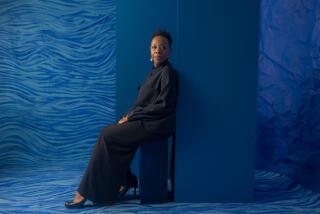Actress Savors Film Career Sweetened by a Grapefruit
Mae Clarke made more than a hundred movies, but a single grapefruit made her famous.
A radiant 75, Clarke is still being asked what Jimmy Cagney’s “citrus massage” in “The Public Enemy” felt like. “Wet,” she answers.
As to how the immortal moment came about, she lights up a cigarette and pauses theatrically for a moment before telling the tale one more time. In its own way, what happened on that day in 1931 is as memorable as what happened at Shiloh. Clarke knows it and is a somewhat coy witness to history.
“I have five different ways of telling it,” she said at her home in Woodland Hills.
She has to, she said, because the public has heard it so often.
What Didn’t Happen
“I got tired of myself telling it, so I began varying it a bit.”
First she reports what didn’t happen.
The breakfast-food assault did not cause her nose to bleed.
And she most emphatically did not say afterward, as one might read in numerous standard film-reference books, “Oh, you son of a bitch, look what you did to me!”
She wanted to sue the reporter who concocted that one.
She would never have spoken to Cagney that way. “I revere him,” she said. “I did at the time. I knew I was working with a pro.”
Actually, she recalled, “I didn’t say anything. I did my job. I knew what he was going to do.”
The citrus shove was not in the script, it’s true, and it’s also true that she would have declined the honor had she known it was going to be in the finished film. “I just did it for the crew to laugh,” she said, recalling that she first learned that director William Wellman had left the scene in when the picture opened.
Fruit Instead of Eggs
“Jimmy’s story is that he knew a ‘gink’ who had lived in his Hell’s Kitchen neighborhood who had a fight with his wife at breakfast and picked up a plate of scrambled eggs and let her have it,” she said. Gink, she explained, was slang for a hood, as was “gazebo.” Being neither gink nor gazebo, Cagney opted for fruit instead of eggs.
“Wellman’s got his version, and Jimmy’s got his, but I’ve damn well got mine. I really think what I told you is the truth, but if Jimmy says it happened his way maybe I’ll buckle under,” she said with a laugh.
Since 1980, Clarke has lived in one of the cottages at the Motion Picture and Television Fund Country House and Hospital. Stepin Fetchit is there, and so is Mary Astor, but neither retired actor is well.
In contrast, evidence of Clarke’s well-being includes a healthy vanity. She graciously declined to be photographed without her false eyelashes or to be tape-recorded because, she said in tones as clipped and clear as actor John Houseman’s, “I have a little hesitancy in my speech lately.”
Dancer on Steeplechase Pier
Clarke was born in Philadelphia and grew up in Atlantic City, N.J. She was 14, dancing on the Steeplechase Pier, when a New York producer discovered her. In New York, she danced in the smart supper clubs and on Broadway. She also fell in love with, and married, Lew Brice, brother of Fanny Brice.
“ ‘I’m going to give you your wedding present in the form of an act,’ ” she recalled that Fanny told her, and engaged Billy Rose to write the original musical-comedy material Lew and Mae successfully performed in vaudeville.
“It didn’t hurt me one bit to be associated with them,” Clarke recalled of the Brices. At 19, Clarke was urged to make a screen test, which she did in New York, and was offered a contract by Fox Talking Pictures. (“That was before the 20th-Century,” she noted.) When she balked at moving to Hollywood, her sister-in-law told her: “ ‘You’re crazy. You’re going to do it,’ ” Clarke recalled.
The year she was hired into the talkies, she said, her father lost his job as a pipe organist for silent movies. Her family joined her in California, and Clarke was able to set them up on a ranch in Canoga Park with 2,000 chickens and a cow.
Rarely Starred
The blonde actress was active in films for 30 years and continued to work in the industry until a decade ago. Her marriage to Brice ended shortly after she came to Hollywood, largely, she said, because his film career never took off as hers did. “To my credit, I never took alimony,” she said of her three brief marriages.
“I never really needed it.”
Clarke rarely starred but had “wonderful parts,” including that of Mollie Malloy in “The Front Page.” “My early notices were almost all the same: ‘She isn’t the greatest beauty . . . ,’ then, accolades!” she recalled.
She said she worked assiduously at her craft. She always tried to be the character she was playing, not simply Mae Clarke. She would query the director and the writers and, more important than questioning them, she said, “I would listen.
“I was a method actor before my time,” she said.
“The audience believed in that girl on the screen, and they liked me for giving that character to them.”
Bankable Ability
Clarke quickly established her bankable ability to create memorable characters like the grapefruit girl in a few scenes. As has been said of “The Public Enemy,” “Does anybody remember who the leading lady was?” (Answer: Jean Harlow).
She points to “Waterloo Bridge,” in which she starred as the fallen ballerina, as the apex of her career. For “my one and only premiere,” she said, she had two escorts, and writer Charles MacArthur and his wife were her guests for dinner at the Brown Derby.
If poet Robert Frost is right and “No memory of having starred/ Atones for later disregard/Or keeps the end from being hard,” Clarke does not show it. After she rises each morning, she said, she drinks a large glass of water and then repeats, “Happy, happy, happy, happy, happy!”
“It makes me laugh at myself,” she explained.
Doesn’t Have Agent
“I don’t miss the industry,” she said, “although I’m proud of it and I’m grateful to it.” She wouldn’t turn down a comeback offer if it came, but right now she doesn’t even have an agent. To get one, she said, “you need to do something to become a hot property. Either you know somebody or you killed somebody or you wrote a book.”
There are consolations. One is having helped create one of the indelible images of her time, part of the cultural loot we all carry around in our heads. And there are friends and occasional appearances to make.
Recently, she was on a radio show talking about James Whale’s “Frankenstein.” Clarke was the leading lady in that horror classic, the only woman in it except for a few maids, female peasants and “Little Maria,” the pretty child murdered by the monster. Clarke asked Little Maria, if she was out there in the listening audience, to get in touch. She called Clarke the next day.
Actors only stay the same forever on the screen.
As Clarke recalled, with astonishment, “Little Maria is 60 years old!”
More to Read
Only good movies
Get the Indie Focus newsletter, Mark Olsen's weekly guide to the world of cinema.
You may occasionally receive promotional content from the Los Angeles Times.









